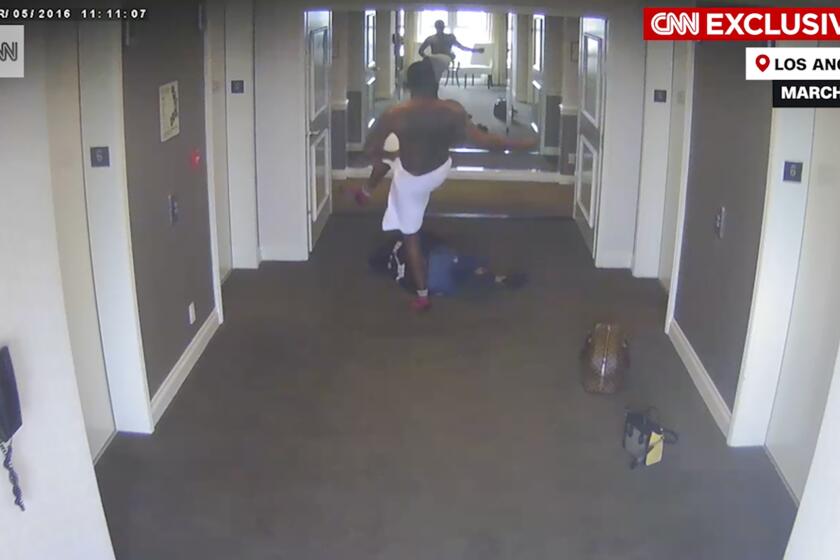Out of the Field : Fillmore Agriculture Teacher to Hang Up His Shovel After 27 Years on the Job
- Share via
He grew up on a farm, he founded and tended and taught at one of the biggest school farms in Southern California and, now that he’s retiring, well, he might just come by and lend a hand from time to time.
Retirement at the end of the school year June 15 won’t be business as usual for Dick Mosbarger, a 27-year agriculture teacher at Fillmore High, but it won’t be all hammocks and martinis either.
Mosbarger has worked seven days a week, all year long, on the high school’s 50-acre farm. He’s corralled farm animals that have broken loose and trotted off down California 126, and he’s pulled tractors from countless ditches. The Fillmore resident has helped generations of students prepare show animals for the Ventura County Fair, and he has shown them how to shear sheep, cut meat and castrate pigs. He’s done everything farmers do--but own a farm.
“If I can’t have my own place,” he said, surveying the 19-year-old demonstration farm’s flower beds and swine units, “this is a lot more than I would have had on my own.”
Mosbarger, 59, is credited with putting together an agricultural education program unmatched in most of Southern California, according to Bob Heuvel, regional agricultural supervisor for the state Department of Education. Heuvel’s region includes Ventura, Los Angeles and Orange counties.
“Dick’s highly respected in the region, particularly among his peers. Fillmore’s school farm--the initiation and design of it--a lot of why they have what they have is due to Dick,” Heuvel said.
What they have includes sheep, cattle, pigs, turkeys, poultry, a slaughter area, a meat laboratory where students learn how to cut up meat and a greenhouse. Animals are taken to market, but crops--particularly the farm’s citrus groves--bring home the farm’s bacon.
The farm’s other major crop, of course, is students. About 125 of Fillmore’s 800 students learn by doing on the farm each year.
Dick Richardson, a citrus grower who is a member of the Fillmore school board, was one of Mosbarger’s students 25 years ago.
“It’s a hard event for a lot of people to see him go,” Richardson said.
“He has always been there, no matter what was needed. One thing I can say--as a student, then as a member of the Agriculture Advisory Committee and now as a board member, and with my own son now in the program--Dick never lost his enthusiasm for teaching. He was as enthusiastic when I was a student as he is now. He has taken the teaching profession seriously. It’s not just a job.”
Others have agreed. Mosbarger was twice named Citizen of Excellence by the California Agriculture Teachers Assn.
Some 500 Fillmore residents are expected at a party Saturday honoring Mosbarger and celebrating the 50th anniversary of the Fillmore chapter of Future Farmers of America--a group Mosbarger belonged to before he graduated from Fillmore High in 1947.
‘More Opportunity’
The ever-impending demise of the family farm has not panicked Mosbarger.
“With corporate farming, we find there is more opportunity to go into agriculture,” Mosbarger said. “During the last five years, 70% of our grads went into related fields--service businesses like pest control, feed stores, the butcher trade. There are a lot of service businesses that support agriculture, which means there are lots of opportunities in the field other than farming.”
Perched on a steel rail fence and deliberating over each word as he spoke, Mosbarger looked and sounded for all the world like the late Henry Fonda. Feelings are expressed carefully, the traditional style among farmers. He would not detail his plans for retirement, other than to say he would pitch in at the farm whenever asked.
Late-Night Calls
“Oh, I’m going to miss it,” Mosbarger said of his farm. Squinting at the sun, despite sitting in the shade, he continued after a moment: “But some of it I won’t, like being called in the middle of the night because the animals are out.”
Mosbarger recalled a middle-of-the-night call from the Sheriff’s Department three months ago, telling him that the farm animals were on the loose again.
“I said I would never count the days to retirement until that night when I came over to put the animals back in and found all the animals had been let out--chickens, pigs, everything--including four animals walking down Highway 126. By the time we got them back in, it was 5 a.m. and, from that day on, I began counting.”
More to Read
Sign up for Essential California
The most important California stories and recommendations in your inbox every morning.
You may occasionally receive promotional content from the Los Angeles Times.









